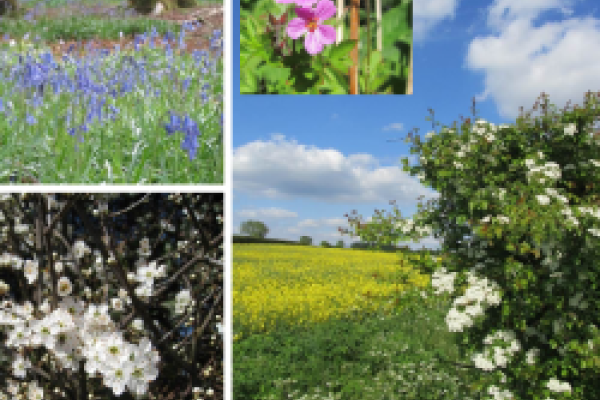Flowering early or shifting north: plants' two alternatives for coping with warming climates

UK plant species in flower. Clockwise from top left: bluebell, (Hyacinthoides non-scripta, Asparagaceae), herb robert, (Geranium robertianum, Geraniaceae, inset), hawthorn (Crataegus monogyna, Rosaceae), and blackthorn (Prunus spinosa, Rosaceae).
Tatsuyo Amano, a post-doc with Professor Bill Sutherland at the University of Cambridge, has been studying plant phenology using complex Bayesian statistical models for a number of years. Part of the project was to investigate whether there was any influence of the phylogenetic (evolutionary) relationships between species in their responses, which is where Simon Queenborough of EEOB helped out.
Dr Amano summarizes the work as follows:
"It is well known that under warming climates some species shift their ranges northward while others don't. What causes this varied response among species is still under debate. In this study we propose that phenological changes, another well-known species response to warming temperatures, may be a reason. Using historical records of distribution and flowering dates of over 200 British plant species, we show that species that have not moved northward in the past few decades instead tracked warming temperatures by advancing their flowering dates, indicating that the two well-known species responses to warming climates are linked in a complementary manner."
More details on Tatsuya's blog
This study complements recent work in the department carried out by graduate student Kellen Calinger. See the Research News article for a discussion.
Reference:
Tatsuya Amano, Robert P. Freckleton, Simon A. Queenborough, Simon W. Doxford, Richard J. Smithers, Tim H. Sparks, and William J. Sutherland. 2014. Links between plant species' spatial and temporal responses to a warming climate Proceedings of the Royal Society B: Biological Sciences 281, in press. DOI: 10.1098/rspb.2013.3017
Abstract To generate realistic projections of species' responses to climate change, we need to understand the factors that limit their ability to respond. Although climatic niche conservatism, the maintenance of a species's climatic niche over time, is a critical assumption in niche-based species distribution models, little is known about how universal it is and how it operates. In particular, few studies have tested the role of climatic niche conservatism via phenological changes in explaining the reported wide variance in the extent of range shifts among species. Using historical records of the phenology and spatial distribution of British plants under a warming climate, we revealed that:
- perennial species, as well as those with weaker or lagged phenological responses to temperature, experienced a greater increase in temperature during flowering (i.e. failed to maintain climatic niche via phenological changes);
- species that failed to maintain climatic niche via phenological changes showed greater northward range shifts; and
- there was a complementary relationship between the levels of climatic niche conservatism via phenological changes and range shifts.
These results indicate that even species with high climatic niche conservatism might not show range shifts as instead they track warming temperatures during flowering by advancing their phenology.
